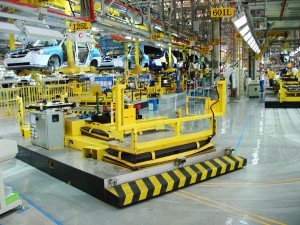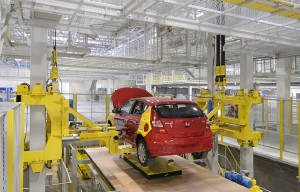Without automated conveyors, modern high-performance facilities could not function, writes Gilles Hernandez, Global Market Manager Automotive at Conductix-Wampfler.
 Being a historical leader in mobile energy and data transmission systems, Conductix-Wampfler has been moving the industry in China for more than two decades. Primarily the activities focus has been the heavy industry sectors, like the electrification of container cranes and mining equipment as these industries have been booming as the economic importance of China was growing in the globalised economy. However since several years, many industry sectors are improving their manufacturing facilities and production means, creating a need for automation and consequently mobile electrified systems. Among these sectors, the automotive industry is playing a major role, pursuing an ideal of high quality products combined with highly efficient and available production equipment.
Being a historical leader in mobile energy and data transmission systems, Conductix-Wampfler has been moving the industry in China for more than two decades. Primarily the activities focus has been the heavy industry sectors, like the electrification of container cranes and mining equipment as these industries have been booming as the economic importance of China was growing in the globalised economy. However since several years, many industry sectors are improving their manufacturing facilities and production means, creating a need for automation and consequently mobile electrified systems. Among these sectors, the automotive industry is playing a major role, pursuing an ideal of high quality products combined with highly efficient and available production equipment.
Conveyor systems play an important role in the automated transport of materials in factories, distribution centres, parcel services, warehouses, airports, hospitals, and others. These systems increase efficiency, quality, sustainability, and traceability of material flow processes, while reducing waste and inventory. Without them, modern high-performance facilities could not function.
The need for flexibility and increased ergonomics in automotive assembly lines is pulling demand for advanced conveyor systems (conveyances) and ergonomic work assist systems.
As an example, skillet lines comprising lifts to adjust the height of the vehicle’s body during the assembly process has become a standard at many car manufacturers. Among these is the Hyundai-Kia Group. Conductix-Wampfler provides specific solutions tailored to this demanding application.
The power supply to the lift tables must be very reliable and involve little maintenance, as the mechanical room to perform this is rather limited. In addition, the system availability must be high.
Both conductor rail and IPT can be used for the application, both bringing different advantages. Conductor rails are known for their reliability but require specific components, eg, entry funnels to guide the current collectors. On the other hand, IPT, as a contactless solution, does not suffer mechanical wear nor limitation in the speed during the transfer operations.
Many of the available conveyor types – AS/RS, sorters, stacker cranes, shuttle systems, skillet lines, AGVs, electric monorail systems – need components designed to deliver electric power and control signals to the moving parts of the systems. These machines might move horizontally, vertically, and/or perpendicular to the storage or work areas. Some systems must meet special challenges, such as high speed, mechanical tolerances, high duty cycles, 3-shifts operation.
For continuously powered systems, the electric power transfer is ordinarily handled by a “conductor rail” system as a first choice. These consist of electrified, insulated rails (one per pole or “wire”) mounted along the movement path of the machine. The moving part(s) of the machine include a set of sliding “collector assemblies” mounted to machine.
The collector slides along the live rails to pick up power and transfer it to the moving parts of the machine. The safety and reliability of the conductor rail system is critical. Rails should be insulated to the “finger safe” (IP2) level. Given that many handling machines run at high speeds and high duty cycles, the rail system must operate flawlessly to avoid significant and costly machine downtime, which could shut down an entire facility. Providing constant power in this manner avoids the need for onboard power generation systems or battery operated systems that must be recharged.
Electrified Monorail System
The main application for conductor rail systems in the automotive industry is Electrified Monorail Systems – EMS. Fully integrated in the production flow of the car assembly or adjacent logistics process, most of the automotive factories feature one or more electrified overhead conveyors.
One of the key characteristics is that one carrier transporting a car, body parts or just-in-sequence delivered dashboard can’t pass the carrier in front. In the case of a malfunction, the entire chain is stopped. Therefore the electrification and controls of the carrier are key to the success of the sequenced production. In the body shop or in the final assembly, different conditions and expectations are set for the electrification system and Conductix-Wampfler address these needs with tailored solutions to the application such as compact and robust current collectors, or reliable transfer points at moving sections.

• Environmental conditions, such as temperature range, contaminants
• Duty cycles
• Mounting consideration, such as available space, connection options,
• Number of conductors
• Current capacity and voltages
• Voltage drop that might occur in a longer runs
• Data transfer needs and the protocols involved.
In summary, it is recommended that the system integrator carefully review the equipment and application with an experienced electrification supplier to choose the correct system and reduce the risk of system failures, equipment downtime, and maintenance.
Besta’Power is a modular system to supply energy and media to moving consumers like tools or machines within a manufacturing facility. It is composed out of a rail, an energy supply system and a carrier.
The system can supply electricity and/or compressed air. Cables and hoses are relocated off the ground while access to the energy is easy and limitless at every position. Work pieces and tools are adapted to the workers’ requirements and located close to the working area. This gives greater safety, with fewer trip hazards or spring effects from spiral hoses; more efficiency due to shorter set up times and fewer interrupted processes; and better ergonomics from the optimally-positioned work pieces and tools.
Tools which are non-battery driven are cheaper, faster, lighter as well as more durable and can handle higher torques. However, if the customer still requires on battery driven tools, the Besta’Power tool transporters provide the ideal placement for the charging stations.
One of the perennial issues with any manufacturing plant is that once in place, changes to assembly lines can be expensive to implement in terms of site works and downtime on the line. So ensuring there is sufficient flexibility to allow for product changes and additional capacity presents challenges, especially when manufacturing trucks, buses and off-highway vehicles, where components are both heavy and dimensionally large. Some plants adopt pits, chains, skillets, lift trucks and cables to manage conveyance, all of which add expensive maintenance costs. Chain-based conveyors and lift trucks are widely used in heavy vehicle manufacturing where vehicles are built to customer specifications on the production line.
A modern, more flexible and transferrable solution to assembly line design has been developed by Conductix-Wampfler, incorporating Inductive Power Transfer (IPT), a contactless power transfer system based on the principle of electromagnetic induction which allows all kinds of moving machines to be supplied with electrical power. Battery-free Automated Guided Vehicles (AGVs) on an IPT line can handle a wide variety of products and are well suited for use in large vehicle assembly, drivetrain pre-assembly lines and at the “marriage line” where subassembles are installed in the truck or bus and where 360-degree access to the line is often a requirement for delivery of JIT sub-assembled vehicle systems from Tier 1 suppliers.







































